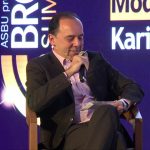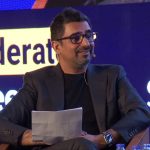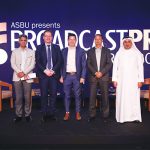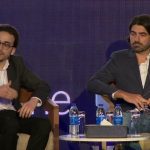In 2009, when the recession hit the world, all eyes were on the Sultanate of Omans public broadcaster, which declared at the time that it was finally ready to take the plunge to High Definition (HD). Unlike most other state broadcasters in the Gulf, Oman had decided to wait until the formats and the technology […]
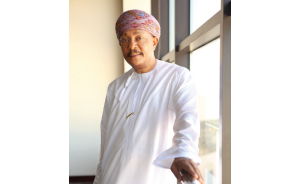
In 2009, when the recession hit the world, all eyes were on the Sultanate of Omans public broadcaster, which declared at the time that it was finally ready to take the plunge to High Definition (HD). Unlike most other state broadcasters in the Gulf, Oman had decided to wait until the formats and the technology around HD had stabilised before taking the plunge. By 2009, the international community seemed to agree that 1080p was the format of the future and enough installations had taken place around the world to iron out the bugs of the first generation of HD equipment. When the downturn forced many broadcasters to cut their budgets, Oman announced ambitious plans to move from an analogue, 4×3, tape-based manual environment to a 1080p, 16×9, file-based fully automated facility in one master project. Almost every local and international systems integrator participated in the subsequent tender but the deal was eventually secured by Sony Professional Solutions Middle East and Africa for a whopping USD 69 million. Two years down the line, with many revisions and additions to the facility, Oman boasts a state-of-the-art TV and radio complex that overlooks the Arabian Sea and comes with full HD and 3G support.
In the meantime, somewhere between 2009 and 2010, some of the dynamics and the political structure at Oman Radio and TV also changed. A new entity called the Public Authority for Radio and TV was established by the Omani government. The entity is headed by His Excellency Dr. Abdulla Al-Harrasi and will have greater operational autonomy. It will also seek to make the media organisation financially independent in the future.
The project which, therefore, began as an Oman Radio and TV project two years ago, is now under the umbrella of the new entity.
Sonys mandate, as chief contractor, was to kit out Oman TVs brand new digital TV studio complex in Muscat and undertake an associated refurbishment of the supporting operation in Salalah to serve the two national TV channels, in addition to a third channel to be launched soon. Alongside this, Sony was to fit out the news section of the state broadcasters five radio channels. All of them are presently housed in the old building, which is attached to the new facility.
Mohammed Al Marhouby, Director General of Engineering at the Public Authority for Radio and TV and the man who oversaw the project from start to finish, says the new centre will be operational from January 2013.
We will begin the shift gradually, Marhouby is quick to explain.
Unlike most other broadcasters in the region who took the phased approach, we took one giant leap from a very old setup to the latest in the market. It calls for a radical shift in the way our staff operates so its not going to be easy. We will start with recording some programmes and producing some live programmes. Then, we will shift to news and other parts of the workflow.
Presently, Oman TV operates two channels although the new facility is kitted out to easily roll out another third or fourth, says Marhouby.
More importantly, a pilot HD channel has been running for the last six months and some special events of Omans National Day Celebrations were produced in HD and transmitted on this channel as well.
The new facility, of course, is several times bigger and better than the old building. This means that the media entity will also have to hire more staff.
We need people with new skills in IT and new broadcast technologies.
The new project is built for HD 1080i from the ground up with the intention of migrating entirely to 1080p in the future. The entire networking infrastructure is 3G compatible. Sony has relied heavily on an IT-based infrastructure for this project and although the facility has a tapeless workflow, it will accommodate some tapes at the ingest stage for now.
This facility is completely file-based and has a fully automated playout environment, explains Marhouby.
We use Sony cameras and systems across several parts of the facility. Pebble Beach is the main playout automation system, while Harris IconMaster serves under Pebble Beach control and it is all driven by a BTS scheduling system.
The facility is built primarily as a three-channel operation, explains Marhouby.
There are four news and four production studios. One of the news studios is embedded in the main newsroom centre on the third floor of the facility with three additional news studios around the building. Of these, one can also operate as a virtual studio with Vizrt solutions should they require it. There is also the capability in the bigger studios to do 5.1 in the production and news environments.
The system is also designed to enable one control room to handle more than one studio. As a result, we have Oman TV 1 and TV 2. TV3 will be launched in the near future. Each channel is created and operated in both SD and HD. The main master control area focuses on the main presentation output and channel control. We then have a main supervision area that has full 5.1 monitoring for production and presentation. The person who mans this area will look after the channel output and also the incoming feeds and associated working in terms of production to ensure that everything is fine.
The sophisticated news section includes one 550sqm newsroom with work areas for at least 40 journalists. The facility uses an Avid iNews system. This area includes a news presentation set for three floor cameras and one mounted on a rail hanging from the ceiling along the newsroom. All of the cameras are on automated, remote-controlled heads and pedestals, with a prompter for the floor cameras. It also includes an ingest/traffic desk to manage incoming news feeds.
Ten non-linear editing (NLE) rooms are connected to a central shared memory architecture that has 250 hours of storage capacity in the chosen standard for this section. Two of the editing suites are dedicated to sport. There are four recording booths for voice-over applications. A news archive and cassettes/tapes ingest room is also available. Ingest will be able to control four simultaneous recordings on two working positions. Three additional 150 sqm studios will be used for news applications such as talk shows, interviews and other programmes. Each of these studios is equipped with four cameras on manual pedestals and heads.
Four galleries for the three studios and the news set in the newsroom are fully equipped for live as well as recorded operations. Each gallery has open access to two channels of a dedicated play-out server, networked to the central shared memory and controlled by the NRCS automation. Each one of the four dual-channel play-out servers is fully mirrored and has a resident memory capacity of a minimum of 50 hours in the chosen standard.
Besides the news studios, systems integrator Sony Professional also took us on a tour of the four production studios of 640, 278, 270 and 232 sqm respectively. While the largest of these is equipped with six cameras, the rest are kitted out with five cameras each with the possibility to use two shared HF wireless cameras. All of the four studios have been wired for an extended use of two more standard cameras. The largest studio includes a large Jib crane while a mini Jib crane occupies one of the smaller studios.
Both the largest and the smallest studios will be equipped with retractable seating for audience. The smallest studio is likely to be dedicated to Channel 2 for sports programmes with the audience, the Sony Professional spokesperson explains.
A similar set up with four galleries for four studios and corresponding parts of the workflow are available within the production environment as well. An audio post production suite includes a dubbing theatre and a mini recording studio.
The playout and traffic section includes a master control room, a multi-format copy lab that includes a 50-channels benchmark recording server system and a multi-DVD jukebox copier.
Initially, there were two automated presentation galleries with each including a small continuity booth with one camera. This has since been expanded to a third presentation gallery that shares the two existing continuity studios.
We have two live Nvision continuity suites, clarifies Marhouby.
Either of those suites can work into any channel. As this is a self-contained environment, we have one continuity suite for Oman TV1 and we have exactly the same for the other but either of these can work into the third channel. What we have built here is a full 5.1 transmisison suite in HD for up to three channels immediately and all of these channels can be expanded into a fourth or more.
He explains that Oman TV also has a Sony HDC-PC1 camera mounted on the roof for 24/7 coverage.
This camera can give us a 360 degree view of the area around and is ideal for wide shots to use in the news studios or as an introduction or for rolling captions at the end.
A significant chunk of this project includes the radio news section, with individual Arabic and English newsrooms for news compilation and monitoring with eight spots for the journalists, producers and editors for each language. All of the workstations are equipped with NRCS client software and browsing software for the Radio Broadcast Management System. This entire area is driven by Netias Radio Assist solution.
There are also two radio recording studios, each of which can accommodate four people. The studios are equipped with microphones, headphones, monitors and intercom. A touch screen of the Telephone screener system, a newsroom computer system client software and a remote of the Radio Broadcast management system has been installed in each studio.
Three radio control rooms share two recording studios. These control rooms can be used for pre-production as well as for live broadcasts. Live broadcasting runs manually or automatically.
Each radio control room is designed to accommodate up to two presenters, simultaneously working at the news desk, and an additional studio guest. The radio control rooms have been equipped with a digital mixing console, audio sources, and an eight-channel digital audio software for mix down and full monitoring, explains Marhouby.
The system design at the facility is flexible and scalable. The infrastructure supports 3G signal transmission, and where possible, 3G-ready equipment has been installed in anticipation of an upgrade in the future.
According to Sony, this project included a fairly complex system that had to be delivered in a very short timescale into a new site that was still being constructed.
The technical rooms located across a large building require a complex design of broadcast and network systems to ensure cable lengths remain within the specified standards for 3G and CAT6 infrastructure, the systems integrator explains.
While the Salalah studios were due for completion at the time of going to press, testing and commissioning for the Muscat facility was completed in Q4 2012 in time for Ramadan productions.
The Salalah studios were refurbished and equipped with the same systems and equipment in order to be compatible with Muscat, particularly the news studio and the newsroom, in addition to some of the production and radio news facilities.
One of the most important aspects of this project is training and Sony has operational assistance staff on site for a year to ensure transfer of skills. We have worked with various partners such as ARRI for lighting, Swiss Media for the radio part of it and GBM among others for various elements of the installation while UAE-based twofour54 and BBC have been offering training.
Oman TV is presently transmitted across the world on different satellites including Arabsat, Nilesat, Hot Bird, PanAmSat, AsiaSat 3 and Galaxy among others.
The next step is to focus on transmitting terrestrial TV, says Marhouby.
We are closely studying the potential of undertaking a DVB-T2 project in Oman as we have to close down all of our old analogue transmitters by 2015. Unlike most other countries in the Gulf, the topology of Oman is very complicated with its mountains and valleys, which is the beauty of the country, but we need more number of transmitters to cover different pockets. This is where we are headed, he says.
Alongside this, more than 80,000 crates of old footage, some dating back to 1974, when the state broadcaster was first launched, are waiting to be digitised at the facility.
Footage in all kinds of formats including two-inch and one-inch tapes, U-matic tapes and more are lying untouched.
We obviously cannot afford to lose them. This is a matter of urgency and the second phase of this project is to engage an archive specialist to undertake this task for us. This building has been designed to house our archives, says Marhouby.
For now, although a big chunk of the HD/3G project is complete, Marhoubys biggest challenge will begin as the operators gradually leave their old ways of operation to adapt to a new way of tapeless life.
Its a tough challenge but Im sure we shall eventually get everyone to adapt, adds Marhouby.










































































